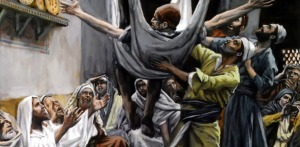On one of those days, as he was teaching, Pharisees and teachers of the law were sitting there who had come from every village of Galilee and Judea and from Jerusalem. And the power of the Lord was with him to heal. And behold, some men were bringing on a bed a man who was paralyzed, and they were seeking to bring him in and lay him before Jesus . . . Luke 5:17-19
Another day, another town, another teaching. His teaching has attracted as much interest as his healing, for the house is packed. Especially “Pharisees and teachers of the law.” Now they show up, these classicadversaries and hypocrites we all love to look down on. But they are not adversaries yet—they are just doing their job as religious experts and legal authorities. Here’s a new teacher, rumored to be Messiah; better check him out. Word has spread through the Pharisee grapevine, even to Jerusalem, and representatives from the temple school are in attendance. Some of these may remember that twelve-year-old boy from twenty-odd years back and have wondered what became of him.
Well, here he is, and the power of the Lord [is] in him to heal (5:17).
With all the lawyers present, talk probably turns on the law, and the discussion was likely to get heavy and intense: q & a, back and forth, red meat for the professionals even if the commoners are having a hard time keeping up with the finer points. The usual contingent of halt and lame are hanging around outside, straining at the windows and listening at the door to catch any hint that the palaver will wrap up soon. Few even notice the man on a blanket hauled by four others, or hear the groans they make upon arriving and seeing the crowds.
What are they talking about inside? What gets the professionals all worked up as they debate the teacher? Sin, maybe—they’re all against it, but the teacher has some interesting ideas about what it actually is. While they try to pin him down on types of sin, he’s going on about the origin of it . . . or something like that. They’re deep into the subject when dust and straw rain down from above, followed by a rasp of stone: a slab of light falls across the teacher’s face. The light widens and more dirt showers the esteemed audience. A bulky form temporarily blocks the opening.
Every Sunday school attendee knows this story, which has a special appear for children. It can’t miss, really: loyal friends, a poor sick man, a kind and gentle Jesus. Comical, too. The pictures are usually imaculate but it was probably very messy; imagine the immaculate lawyers shaking dirt out of their beards and robes while spitting clods of plaster. They are evidently the witnesses Jesus has in mind when he gazes at the paralyzed (and probably very embarrassed) victim on the stretcher and says, “Man, your sins are forgiven.”
Really? Sin? Where did that come from?
It comes from the garden and from the heart. Scholars of the law are quite aware of what he just said. In the midst of robe-shaking and sputtering they freeze, all with the same thought. Only God can forgive sins. Who is he claiming to be? He knows their thoughts and sees the inevitable collision down the road. But now, after weeks of establishing his authority–over the demonic powers, the fevers and eczemas, the twisted bones and withered limbs–he stakes a claim of authority over sin itself, which is the sting of death–“and the power of sin is the law” (I Cor. 15:56). This one is for the lawyers: “Rise up, pick up your mat, and go home.”
True healing begins with forgiveness. A wretched sinner, paralyzed in a hardened heart, feels his lifeless muscles waken. Rise up! makes them tingle, laugh, leap for joy. All embarrassment forgotten, he bows before his healer while gathering up the mat. And then he goes home, the happiest object lesson in the world—and a little fable of a future rising-up. For the last enemy to be destroyed is death.
For the first post in this series, go here
Next>
